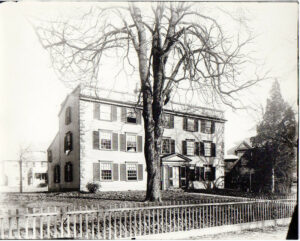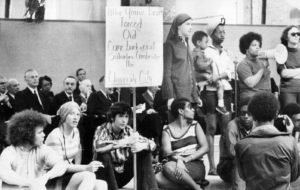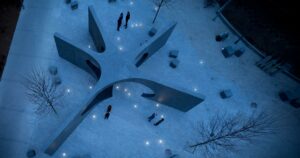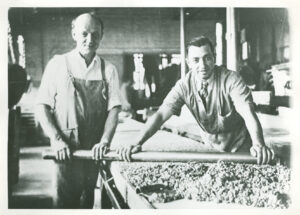
What is in a name? The origins of Cambridge Public Elementary Schools’ Nomenclature
By Talia Franks, 2022
The Cambridge Public Schools website lists four early childhood education programs, twelve elementary schools, five upper schools, and three high schools. Each of these schools has its own rich history of how it came to be what and where it is today. Below, we will explore the origins of the names of Cambridge’s twelve elementary schools.
The Baldwin School (85 Oxford Street) is named for the first Black woman principal in the Northeast, Maria L. Baldwin. The school was originally named in 1874 for Harvard Professor and proto-eugenist Louis Agassiz, however the School Committee voted unanimously in 2002 to rename the school for Baldwin, who was appointed principal of the school in1889. Under her leadership the student body grew to the point that the decision was made, with her prompting, to build a new school in 1915. When the new school was completed in 1916, Baldwin was appointed Master, a position she held until her death in 1922.[1]
The name change was initiated by then-student Nathaniel Vogel who was motivated to change the school’s name after reading Harvard Professor of Zoology Stephen Jay Gould’s writings about Louis Agassiz’s theories of scientific racism. Vogel testified that Agassiz’s legacy in education was one of hate and did not reflect the diverse student body of the school. Baldwin’s name, he said, was one that would live up to the school.[2]
The Peabody School (70 Rindge Avenue) was founded in 1889. It is named in honor of Reverend Andrew P. Peabody, an accomplished scholar who championed many causes during his life, including peace, the end of slavery, the education of women, and better treatment for the mentally ill. The Peabody School shares a building with the Rindge Avenue Upper School.[3]

The Fletcher-Maynard Academy (225 Windsor Street) is the result of the merger of two schools, the Fletcher School and the Maynard School. The Fletcher School was renamed in 1907 for Ruel Hasseltine Fletcher who had served as the school’s principal for 50 years[4], first as the Otis School before it was rebuilt as the Thorndike School in 1861.[5] The Maynard was renamed from the Roberts Elementary School in 1986 in honor of Joseph Maynard, who died suddenly in the fall of 1985 following his twelfth re-election to the Cambridge School Committee.[6] A Steering Committee composed of parents, teachers, community members, and Cambridge Public Schools central office staff was elected in 1999 to discuss the merging of the Fletcher and Maynard Schools. They worked together to develop a turnaround plan for the schools centered on establishing a single new school, the Fletcher-Maynard Academy, which opened its doors to students in September of 2000.[7]
The Amigos School (15 Upton Street) is a dual language immersion school with Spanish and English catering to students between Kindergarten and the Eighth grade. “Amigos” is a Spanish word that translates to “Friends” in English. The Amigos school began as a program at the Maynard School in 1986. It had expanded to a K-8 program by the mid-1990s, with grades K-3 housed at the Maynard School and grades 4-8 at the Robert F. Kennedy School building. In 1997 the K-8 grades of the program were consolidated at the Kennedy School, and in the Spring of 2001 the Cambridge School Committee voted to make the program an autonomous school within the Kennedy School building after considerable lobbying efforts by Amigos parents. Bilingual students who had been housed at the Longfellow School were incorporated into the Amigos School in 2002. The Amigos school was later moved to the King School building as a result of the School Consolidation plan passed by the Cambridge School Committee in the late 2003-04 academic year.[8] In subsequent years the Amigos School was moved again to Upton Street.
The Cambridgeport School (89 Elm Street) is simply named, as it began in the 1990-91 school year with a single kindergarten class in the Cambridgeport section of Cambridge before moving ten years later into the former Fletcher School building in the Port (formerly known as Area 4). The school remains small, with about 250 students in Preschool (Special Start)-5th grade.[9]
The Dr. Martin Luther King, Jr. School (102 Putnam Avenue) is named for Dr. Martin Luther King, Jr. It was renamed from the former Houghton School in 1968 shortly after Dr. Martin Luther King, Jr.’s death.[10] The Houghton school was erected in 1904 and named for ex-mayor Henry O. Houghton.[11]
The King Open School (850 Cambridge Street) was founded in 1975 within the King School, by a group of parents who wanted to take an active role (with staff) in the education process and for their children to have access to an open classroom-style school .[12] Originally housed in the Dr. Martin Luther King, Jr. School on Putnam Avenue, it moved to the brand new King Open and Cambridge Street Upper Schools and Community Complex on Cambridge Street in 2019.
The Graham and Parks School (44 Linnaean Street) is the result of a merger of the Cambridge Alternative Public School (CAPS) with the Webster School in 1981. CAPS was a small, nationally acclaimed magnet school founded in 1971, while the Webster school was a small, traditional neighborhood school built in 1854 and named for Daniel Webster. It was named the Graham and Parks school for Cantabrigian politician and community leader Saundra Graham and civil rights activist Rosa Parks.[13]

The Morse School (40 Granite Street) was founded as a K-8 in 1891. It is named for Asa P. Morse, who was an active member of the Cambridge community. At the time the school was dedicated, he was the second longest-serving member of the Cambridge School Board.[14]
The Kennedy-Longfellow School (158 Spring Street) is the result of a merger between the Longfellow School, named for Henry Wadsworth Longfellow, and the Robert F. Kennedy School. The Kennedy school was originally dedicated on June 10, 1973. David Powers, a confidant of President John F. Kennedy and close friend of former Attorney General Robert F. Kennedy was quoted as saying during the dedication ceremony that Robert Kennedy’s closeness to Cambridge and Charlestown was due to the fact that “… it was here that he received his baptism of fire in politics.” In addition, he said, Kennedy would be proud to have the school named for him because he was fond of children and held their best interests as one of his highest priorities.[15]
The Haggerty School (110 Cushing Street) is named for Cantabrigian Daniel A. Haggerty, the first U.S. soldier to sacrifice his life during the 1914 invasion of Vera Cruz, Mexico. Before its official naming in 1915, it was unofficially known as “The Mount Auburn School.”[16]
The Tobin Montessori School (currently located at 359 Broadway) is named after educator and school superintendent John Tobin. As the Tobin School, it replaced the Russell School which was located on Grozier Road, with its first graduating class in 1972. A transition was begun in 2007 when Dr. Fowler-Finn, the superintendent of schools at the time, created a Montessori School which was housed at the Tobin. As each new class of Montessori children came through, the standard classroom was eliminated. Since the 2012-13 school year, all children up to grade five have been housed in Montessori classrooms.[17]
The Tobin Montessori School is currently located in a swing space in the old Longfellow School on Broadway, awaiting the completion of a new school complex on Vassal Lane. When completed, the complex will house the Vassal Lane Upper School as well as Tobin Montessori.[18]
The complete history of all of the Cambridge Public Schools is huge and varied, and beyond the scope of one simple article. We will be completing another deep dive into Cambridge Public Schools — in particular the Cambridge Ringe and Latin School, which has a history of over 370 years — in the coming months. In the meantime, do you have personal experience with Cambridge Public Schools? Email info@historycambridge.org and let us know what we missed!
This article was originally published in our “Did You Know?” column in Cambridge Day.
[1] Baldwin School. “History of the Baldwin School – The Maria L. Baldwin School.” Cambridge Public Schools. Accessed March 24, 2022. https://baldwin.cpsd.us/cms/One.aspx?portalId=3043283&pageId=3579044
[2] Dorgan, Lauren R. “Committee Renames Local Agassiz School.” The Harvard Crimson. May 22, 2002. https://www.thecrimson.com/article/2002/5/22/committee-renames-local-agassiz-school-the/
[3] Peabody School. “History of the Peabody School” Cambridge Public Schools. Accessed March 29, 2022. https://peabody.cpsd.us/about_our_school/history_of_the_peabody_school
[4] “Mr. Fletcher Honored.” The Cambridge Sentinel, 4, no. 31. June 22, 1907. https://cambridge.dlconsulting.com/?a=d&d=Sentinel19070622-01.2.48&e=——-en-20–1–txt-txIN——- (Accessed March 29, 2022).
[5] “Tribute to Ruel H. Fletcher.” The Cambridge Tribune, XXX, no. 20. July 13, 1907. https://cambridge.dlconsulting.com/?a=d&d=Tribune19070713-01.2.43&e=——-en-20–1–txt-txIN——- (Accessed March 29, 2022).
[6] “School Renamed for Joseph E. Maynard” The Cambridge Chronicle, 140, no. 24. June 12, 1986. https://cambridge.dlconsulting.com/?a=d&d=Chronicle19860612-01.2.40&e=——-en-20–1–txt-txIN——- (Accessed March 29, 2022).
[7] Fletcher Maynard Academy. “History of Fletcher Maynard Academy” Cambridge Public Schools. Accessed March 29, 2022. https://fma.cpsd.us/about_our_school/history_of_fletcher_maynard_academy
[8] Amigos School JK-8 “School History / Historia De La Escuela.” Cambridge Public Schools. Accessed March 29, 2022. https://amigos.cpsd.us/about_our_school/school_history
[9] Cambridgeport School. “History and Philosophy” Cambridge Public Schools. Accessed March 29, 2022. https://cambridgeport.cpsd.us/about_our_school/history_and_philosophy
[10] “New Houghton School Building To be Named for Doctor King” The Cambridge Chronicle, April 11, 1968. https://cambridge.dlconsulting.com/?a=d&d=Chronicle19680411-01.2.4&e=——-en-20–1–txt-txIN——- (Accessed March 31, 2022).
[11] “School Committee Meeting” The Cambridge Tribune, XXVII, no. 12. May 21, 1904 https://cambridge.dlconsulting.com/?a=d&d=Tribune19070713-01.2.43&e=——-en-20–1–txt-txIN——- (Accessed April 1, 2022).
[12] King Open School. “History of King Open” Cambridge Public Schools. Accessed March 29, 2022. https://kingopen.cpsd.us/about_our_school/history_of_king_open
[13] Graham and Parks School “Timeline” Cambridge Public Schools. Accessed March 29, 2022. https://grahamandparks.cpsd.us/cms/One.aspx?portalId=3043838&pageId=3657703
[14] Morse School. “Artwork Found Within the Walls of Morse School” Cambridge Public Schools. Accessed March 29, 2022. https://morse.cpsd.us/cms/One.aspx?portalId=3044391&pageId=3675832
[15] “Kennedy School dedicated Sunday” The Cambridge Chronicle, June 14, 1973. https://cambridge.dlconsulting.com/?a=d&d=Chronicle19730614-01.2.51&e=——-en-20–1–txt-txIN——- (Accessed April 1, 2022).
[16] Haggerty School “History of the Haggerty School” Cambridge Public Schools. Accessed March 29, 2022. https://haggerty.cpsd.us/about_our_school/history_of_the_haggerty_school
[17] Tobin Montessori School. “History of Tobin Montessori” Cambridge Public Schools. Accessed March 29, 2022. https://tobin.cpsd.us/about_our_school/history_of_the_john_m__tobin_school
[18] Tobin Montessori School. “History of Tobin Montessori” Cambridge Public Schools. Accessed March 29, 2022. https://tobin.cpsd.us/about_our_school/history_of_the_john_m__tobin_school







